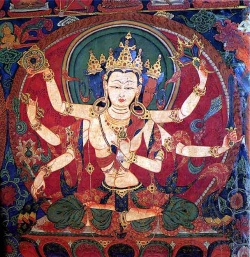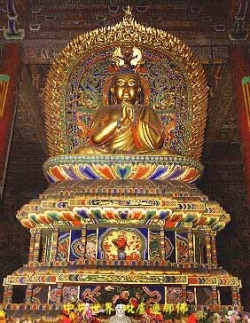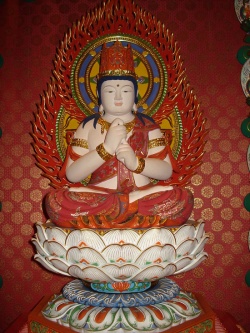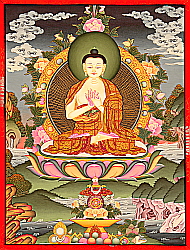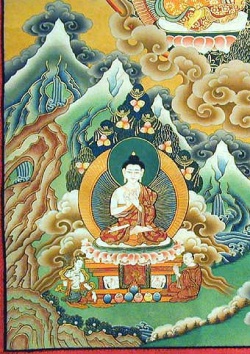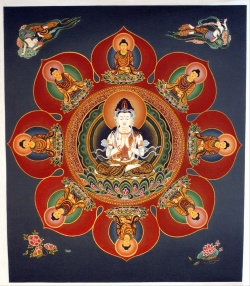Difference between revisions of "The Meditation of Vairocana"
(Created page with "<poem> The Meditation of Vairocana First we must learn the seven point meditation posture, which is also known as the seven points of Vairocana. This m...") |
m (Text replacement - "]]]" to "]])") |
||
| (One intermediate revision by one other user not shown) | |||
| Line 1: | Line 1: | ||
| − | <poem> | + | [[File:VairocanaDemchokT.jpg|thumb|250px|]][[File:Vairoca21na 2.jpg|thumb|250px|]][[File:Vairoc78ana.jpg|thumb|250px|]][[File:Vairoc4ana1.jpg|thumb|250px|]][[File:Vairoc4ana.jpg|thumb|250px|]] |
| + | <poem>[[File:Vairocana77.jpg|thumb|250px|]] | ||
The [[Meditation]] of [[Vairocana]] | The [[Meditation]] of [[Vairocana]] | ||
| Line 6: | Line 7: | ||
Sitting in the full [[lotus position]] allows the [[body]] and [[mind]] to stay in complete {{Wiki|equilibrium}}, removing discursive [[thoughts]] and facilitating {{Wiki|blood}} circulation. It allows the [[body]] to remain soft yet able to endure {{Wiki|hardships}}. Through the seven point [[meditation]] [[posture]], one may obtain [[primordial wisdom]], achieve [[meditational]] stability, and directly attain [[Buddhahood]]. | Sitting in the full [[lotus position]] allows the [[body]] and [[mind]] to stay in complete {{Wiki|equilibrium}}, removing discursive [[thoughts]] and facilitating {{Wiki|blood}} circulation. It allows the [[body]] to remain soft yet able to endure {{Wiki|hardships}}. Through the seven point [[meditation]] [[posture]], one may obtain [[primordial wisdom]], achieve [[meditational]] stability, and directly attain [[Buddhahood]]. | ||
| − | Why is it called the seven points of [[Vairocana]]? It is because [[Vairocana | + | Why is it called the seven points of [[Vairocana]]? It is because [[Vairocana Buddha]] is the central [[Dhyani Buddha]] of the [[Five Buddhas]], known also as the [[Great Sun]] [[Tathagata]] ([[Dainichi Nyorai]]). [[Vairocana]] is the principal [[deity]] of [[Esoteric Buddhism]], and is the main [[deity]] of both the [[Vajradhatu Mandala]] and [[Garbhadhatu Mandala]], [[symbolizing]] [[Universal]] [[Illumination]]. |
| − | The image of [[Vairocana]] within the [[Diamond]], or [[Vajradhatu]], [[Mandala]] is known as the [[Wisdom Truth Body]] of the [[Great Sun]], in which he displays the Wisdom-Fist [[Mudra]]. The image of [[Vairocana]] in the [[Womb]], or [[Garbhadhatu]], [[Mandala]], represents the [[principle]] or [[reason]] (in [[Japanese]], Ri) aspect of [[Dainichi]], and is known as the [[Principle]] [[Truth Body]] of the [[Great Sun]]. In this image [[Vairocana]] displays the [[Dharmadhatu]] [[Mudra]] (in [[Japanese]], Hokaijyo-in). | + | The image of [[Vairocana]] within the [[Diamond]], or [[Vajradhatu]], [[Mandala]] is known as the [[Wisdom Truth Body]] of the [[Great Sun]], in which he displays the Wisdom-Fist [[Mudra]]. The image of [[Vairocana]] in the [[Womb]], or [[Garbhadhatu]], [[Mandala]], represents the [[principle]] or [[reason]] (in [[Japanese]], Ri) aspect of [[Dainichi]], and is known as the [[Principle]] [[Truth Body]] of the [[Great Sun]]. In this image [[Vairocana]] displays the [[Dharmadhatu]] [[Mudra]] (in [[Japanese]], [[Hokaijyo]]-in). |
According to the [[Buddhist]] [[sutra]], the image of [[Vairocana]] is described as follows: [[Vairocana]] sits on an [[eight-petalled lotus]] [[throne]]; he has a [[body]] {{Wiki|gold}} in {{Wiki|colour}}, appearing like a [[Bodhisattva]] seated cross-legged on a [[jewel]] [[lotus]], wearing a five [[Buddha]] [[precious]] {{Wiki|crown}} painted white. His back is adorned with the combined five coloured circular [[light]], his head is encircled with a cloud, and his [[body]] is encircled in a colourful [[aura]] of multi-layered lights. He appears with shoulder-length, deep maroon [[hair]] and long, pierced [[earlobes]] adorned with {{Wiki|gold}} earrings. His neck is adorned with layers of ornaments and [[precious]] [[jewels]], {{Wiki|pearl}} and jade necklaces, blue {{Wiki|pearl}} ornaments and a garland that hangs down to his knees. His arms are adorned with {{Wiki|pearl}} and jade armlets, and his wrists are decorated with {{Wiki|gold}} [[bracelets]], which may also be worn on his upper arms. His hands are placed together, palms facing upward, with the left palm covering the right palm; the thumbs of each hand {{Wiki|touch}} each other, placed beneath the [[navel]] to display the image of entering absorption. He is dressed in [[light]], white [[celestial]] clothing, wears a skirt made of different textiles such as blue brocade and {{Wiki|silk}}, and his waist is wrapped with a green girdle belt. | According to the [[Buddhist]] [[sutra]], the image of [[Vairocana]] is described as follows: [[Vairocana]] sits on an [[eight-petalled lotus]] [[throne]]; he has a [[body]] {{Wiki|gold}} in {{Wiki|colour}}, appearing like a [[Bodhisattva]] seated cross-legged on a [[jewel]] [[lotus]], wearing a five [[Buddha]] [[precious]] {{Wiki|crown}} painted white. His back is adorned with the combined five coloured circular [[light]], his head is encircled with a cloud, and his [[body]] is encircled in a colourful [[aura]] of multi-layered lights. He appears with shoulder-length, deep maroon [[hair]] and long, pierced [[earlobes]] adorned with {{Wiki|gold}} earrings. His neck is adorned with layers of ornaments and [[precious]] [[jewels]], {{Wiki|pearl}} and jade necklaces, blue {{Wiki|pearl}} ornaments and a garland that hangs down to his knees. His arms are adorned with {{Wiki|pearl}} and jade armlets, and his wrists are decorated with {{Wiki|gold}} [[bracelets]], which may also be worn on his upper arms. His hands are placed together, palms facing upward, with the left palm covering the right palm; the thumbs of each hand {{Wiki|touch}} each other, placed beneath the [[navel]] to display the image of entering absorption. He is dressed in [[light]], white [[celestial]] clothing, wears a skirt made of different textiles such as blue brocade and {{Wiki|silk}}, and his waist is wrapped with a green girdle belt. | ||
| Line 22: | Line 23: | ||
Keep the {{Wiki|chest}} up and slightly move the shoulders backward. The chin is slightly tucked in, just as a soldier would raise his {{Wiki|chest}} and tuck his chin in training. | Keep the {{Wiki|chest}} up and slightly move the shoulders backward. The chin is slightly tucked in, just as a soldier would raise his {{Wiki|chest}} and tuck his chin in training. | ||
| − | Press the {{Wiki|tongue}} lightly against the upper palate. This is of [[vital]] importance, as it is what {{Wiki|Taoists}} would call bridging [[heaven]] and [[earth]] or building a [[celestial]] bridge. When [[animals]] enter into hibernation, their tongues rest in a position {{Wiki|touching}} the upper palate. When a [[practitioner]] initially enters into the practice of [[Mahamudra]]e would not be able to truly enter into [[tranquility]] if his {{Wiki|tongue}} does not {{Wiki|touch}} his upper palate. In [[India]], the act of pressing the {{Wiki|tongue}} against the upper palate is called [[Khechari]]. This is not performed simply by {{Wiki|touching}} the upper roof of the palate with the {{Wiki|tongue}}, but also involves rolling the {{Wiki|tongue}} backwards so that it reaches deep into the {{Wiki|throat}} (slipping behind the nasopharynx) and presses against either nasal opening. In this way, one achieves [[balance]] between [[body]] and [[mind]], for the disruptive flow of [[breath]] is [[calmed]]. In this way [[life]] can be prolonged, and ones [[essence]] is kept in place without depletion. The pressing of the {{Wiki|tongue}} against the upper palate requires bending the {{Wiki|tongue}} like a hook to hook against the inner nostril. The [[Wikipedia:Taoism|Taoist]] [[views]] the {{Wiki|tongue}} as a bridge between ones shen or [[spirit]], which resides in the head, and ones [[body]] and [[heart]]. | + | Press the {{Wiki|tongue}} lightly against the upper palate. This is of [[vital]] importance, as it is what {{Wiki|Taoists}} would call bridging [[heaven]] and [[earth]] or building a [[celestial]] bridge. When [[animals]] enter into hibernation, their tongues rest in a position {{Wiki|touching}} the upper palate. When a [[practitioner]] initially enters into the practice of [[Mahamudra]]e would not be able to truly enter into [[tranquility]] if his {{Wiki|tongue}} does not {{Wiki|touch}} his upper palate. In [[India]], the act of pressing the {{Wiki|tongue}} against the upper palate is called [[Khechari]]. This is not performed simply by {{Wiki|touching}} the upper roof of the palate with the {{Wiki|tongue}}, but also involves rolling the {{Wiki|tongue}} backwards so that it reaches deep into the {{Wiki|throat}} (slipping behind the [[nasopharynx]]) and presses against either nasal opening. In this way, one achieves [[balance]] between [[body]] and [[mind]], for the disruptive flow of [[breath]] is [[calmed]]. In this way [[life]] can be prolonged, and ones [[essence]] is kept in place without depletion. The pressing of the {{Wiki|tongue}} against the upper palate requires bending the {{Wiki|tongue}} like a hook to hook against the inner nostril. The [[Wikipedia:Taoism|Taoist]] [[views]] the {{Wiki|tongue}} as a bridge between ones shen or [[spirit]], which resides in the head, and ones [[body]] and [[heart]]. |
The next aspect of [[Vairocana]] [[meditation]] is the act of gazing at an [[object]]. Most practitioners of the [[Mahamudra]] may sit cross-legged in the [[lotus posture]], with the hands positioned beneath the [[navel]] (resting on the lap), lift the {{Wiki|chest}}, and press the {{Wiki|tongue}} against the upper palate, yet their [[minds]] may still wonder, generating discursive [[thoughts]]. Thus, when we want to pacify the [[mind]], we must begin by focusing on one point. The training starts with a [[person]] taking an [[object]], placing it within five and a half feet of their gaze, and {{Wiki|concentrating}} on it without letting the gaze waver. In [[time]], one should be able to gaze longer, and once the focus is fixed, the [[mind]] is stabilized. Otherwise, the [[mind]] wanders. When the [[mind]] drifts away, the lackluster gaze makes the [[person]] appear dull. Therefore, one must begin with training the [[mind]] to focus on one point, as that is the key to pacifying the [[mind]]. | The next aspect of [[Vairocana]] [[meditation]] is the act of gazing at an [[object]]. Most practitioners of the [[Mahamudra]] may sit cross-legged in the [[lotus posture]], with the hands positioned beneath the [[navel]] (resting on the lap), lift the {{Wiki|chest}}, and press the {{Wiki|tongue}} against the upper palate, yet their [[minds]] may still wonder, generating discursive [[thoughts]]. Thus, when we want to pacify the [[mind]], we must begin by focusing on one point. The training starts with a [[person]] taking an [[object]], placing it within five and a half feet of their gaze, and {{Wiki|concentrating}} on it without letting the gaze waver. In [[time]], one should be able to gaze longer, and once the focus is fixed, the [[mind]] is stabilized. Otherwise, the [[mind]] wanders. When the [[mind]] drifts away, the lackluster gaze makes the [[person]] appear dull. Therefore, one must begin with training the [[mind]] to focus on one point, as that is the key to pacifying the [[mind]]. | ||
| − | The first of the five [[lineages]] of [[Tantrayana]] is the [[Tathagata]] [[lineage]], known also as the [[Buddha lineage]]. The principal [[Buddha]] of the [[Buddha lineage]] is [[Vairocana]] [[Buddha]]. The mother of the [[Tathagata]] [[lineage]] is [[Bodhisattva]] [[Buddha Eye]] ([[Locana]]). The [[Light]] [[King]] of the [[Tathagata]] [[lineage]] is Vijayosnisa. The [[Wrathful]] One is [[Acala]]. The [[consort]] of the [[Tathagata]] [[Lineage]] is Aparajitavidyarajni. The [[heart]] of the [[Tathagata]] [[lineage]] involves [[secret mantras]]. These constitute the divisions of the [[Buddha lineage]], which also includes their many {{Wiki|retinues}}. When we begin the practice of [[Mahamudra]]e must first learn the [[meditation]] [[posture]] of [[Vairocana]] so that we may gain access into the [[Buddha lineage]] and attain [[Buddhahood]] within this very [[body]]. | + | The first of the five [[lineages]] of [[Tantrayana]] is the [[Tathagata]] [[lineage]], known also as the [[Buddha lineage]]. The principal [[Buddha]] of the [[Buddha lineage]] is [[Vairocana]] [[Buddha]]. The mother of the [[Tathagata]] [[lineage]] is [[Bodhisattva]] [[Buddha Eye]] ([[Locana]]). The [[Light]] [[King]] of the [[Tathagata]] [[lineage]] is Vijayosnisa. The [[Wrathful]] One is [[Acala]]. The [[consort]] of the [[Tathagata]] [[Lineage]] is [[Aparajitavidyarajni]]. The [[heart]] of the [[Tathagata]] [[lineage]] involves [[secret mantras]]. These constitute the divisions of the [[Buddha lineage]], which also includes their many {{Wiki|retinues}}. When we begin the practice of [[Mahamudra]]e must first learn the [[meditation]] [[posture]] of [[Vairocana]] so that we may gain access into the [[Buddha lineage]] and attain [[Buddhahood]] within this very [[body]]. |
| − | Know that the cross-legged full [[lotus position]] is meant to take advantage of the circulation of xiaxing [[chi]] (downward moving [[energy]] which covers the area from the [[navel]] to the toes), and is not a pose taken for {{Wiki|aesthetic}} [[reasons]]. It is a position that facilitates the smooth circulation of the downward moving [[energy]]. | + | Know that the cross-legged full [[lotus position]] is meant to take advantage of the circulation of [[xiaxing]] [[chi]] (downward moving [[energy]] which covers the area from the [[navel]] to the toes), and is not a pose taken for {{Wiki|aesthetic}} [[reasons]]. It is a position that facilitates the smooth circulation of the downward moving [[energy]]. |
Place the hands evenly [on your lap], with the tips of the middle fingers {{Wiki|touching}} each other, and keep the thumbs close to the lower portion of the index fingers. This keeps the [[body]] and [[mind]] in complete [[balance]], and allows the [[body]] temperature, the circulation of [[chi]] and {{Wiki|blood}} circulation to stay in good [[balance]]. | Place the hands evenly [on your lap], with the tips of the middle fingers {{Wiki|touching}} each other, and keep the thumbs close to the lower portion of the index fingers. This keeps the [[body]] and [[mind]] in complete [[balance]], and allows the [[body]] temperature, the circulation of [[chi]] and {{Wiki|blood}} circulation to stay in good [[balance]]. | ||
| Line 34: | Line 35: | ||
By raising the {{Wiki|chest}} and tucking in the chin, the [[spirit]] and [[energy]] circulate throughout the whole [[body]] without [[hindrance]]. If we do not raise our {{Wiki|chest}} and tuck our chin, insufficiency of [[spirit]] and [[energy]] will lead to falling asleep during practice. Many have asked me why they fall asleep upon entering [[meditation]]. This is all due to the {{Wiki|chest}} not being raised and the chin not being tucked in, resulting in an absence of [[spirit]] and [[energy]]. Too much [[relaxation]] will lead to falling asleep. | By raising the {{Wiki|chest}} and tucking in the chin, the [[spirit]] and [[energy]] circulate throughout the whole [[body]] without [[hindrance]]. If we do not raise our {{Wiki|chest}} and tuck our chin, insufficiency of [[spirit]] and [[energy]] will lead to falling asleep during practice. Many have asked me why they fall asleep upon entering [[meditation]]. This is all due to the {{Wiki|chest}} not being raised and the chin not being tucked in, resulting in an absence of [[spirit]] and [[energy]]. Too much [[relaxation]] will lead to falling asleep. | ||
| − | When the {{Wiki|tongue}} is pressed against the upper palate, it allows the shangxing [[chi]] (upward-moving [[wind]], or [[Udana]] in [[Sanskrit]]) to move downward, and the xiaxing [[chi]] (downward-moving [[wind]] or [[Apana]] in [[Sanskrit]]) to move upwards. The two [[energy]] currents nurture each other through this approach. This important point shall be elucidated in chapter four. | + | When the {{Wiki|tongue}} is pressed against the upper palate, it allows the [[shangxing]] [[chi]] (upward-moving [[wind]], or [[Udana]] in [[Sanskrit]]) to move downward, and the [[xiaxing]] [[chi]] (downward-moving [[wind]] or [[Apana]] in [[Sanskrit]]) to move upwards. The two [[energy]] currents nurture each other through this approach. This important point shall be elucidated in chapter four. |
| − | The act of gazing at one [[object]], which is also the method of Focusing the [[Spirit]] into the Tianxin Location [the forehead, the seat of the [[spiritual]] [[eye]] | + | The act of gazing at one [[object]], which is also the method of Focusing the [[Spirit]] into the [[Tianxin Location]] [the forehead, the seat of the [[spiritual]] [[eye]]), is a major training of The [[Illuminated]] Way of [[Meditation]]d helps to focus the [[mind]] on one point. With this focus of [[mind]], one enters into [[meditative]] absorption. We can place a [[vajra]] or [[dorje]] about five and a half feet away from us and gaze at it. The [[vajra]] is a [[precious]] [[Tantric]] [[ritual]] [[object]] [[symbolizing]] indestructibility. When we look at the [[vajra]], we should revere it as though it were the {{Wiki|Chinese}} [[emperors]] elongated jade tablet. This will make the [[meditation]] meaningful and {{Wiki|tangible}}. |
[[Vairocana]], the [[Great Sun]] [[Tathagata]], once expounded the [[dharma]] at the abode of [[Mahesvara]]. The [[Tathagata]] at that [[time]] had appeared in a [[body]] of {{Wiki|gold}}, with his [[hair]] piled on top of his head, forming a topknot ([[Sanskrit]]: [[ushnisha]]) that appeared like a {{Wiki|crown}} with the [[Five Buddhas]] seated on it. The [[Tathagata]] was radiating lights of many colours, and was clothed in {{Wiki|silk}} like a white [[celestial]] robe. This is a sign of [[attaining]] [[perfect enlightenment]] in the [[Suddhavasa]] [[Heaven]]. Some [[people]] assume that [[Vairocana]], the [[Great Sun]] [[Tathagata]], is the [[Sun God]]. However, I [[feel]] that while the [[Great Sun]] [[Tathagata]] is {{Wiki|synonymous}} with the {{Wiki|sun}} itself, which turns darkness into [[brightness]], the suns [[light]] is divided into day and night, and there are places where sunlight can never reach. Thus, the [[word]] great is added to the [[word]] {{Wiki|sun}} to signify that the [[light]] of the [[Buddha]] is undivided by day or night, interior or exterior areas, as the [[wisdom]] [[light]] of the [[Great Sun]] [[Tathagata]] shines completely in [[equanimity]] throughout all [[dharma realms]]. | [[Vairocana]], the [[Great Sun]] [[Tathagata]], once expounded the [[dharma]] at the abode of [[Mahesvara]]. The [[Tathagata]] at that [[time]] had appeared in a [[body]] of {{Wiki|gold}}, with his [[hair]] piled on top of his head, forming a topknot ([[Sanskrit]]: [[ushnisha]]) that appeared like a {{Wiki|crown}} with the [[Five Buddhas]] seated on it. The [[Tathagata]] was radiating lights of many colours, and was clothed in {{Wiki|silk}} like a white [[celestial]] robe. This is a sign of [[attaining]] [[perfect enlightenment]] in the [[Suddhavasa]] [[Heaven]]. Some [[people]] assume that [[Vairocana]], the [[Great Sun]] [[Tathagata]], is the [[Sun God]]. However, I [[feel]] that while the [[Great Sun]] [[Tathagata]] is {{Wiki|synonymous}} with the {{Wiki|sun}} itself, which turns darkness into [[brightness]], the suns [[light]] is divided into day and night, and there are places where sunlight can never reach. Thus, the [[word]] great is added to the [[word]] {{Wiki|sun}} to signify that the [[light]] of the [[Buddha]] is undivided by day or night, interior or exterior areas, as the [[wisdom]] [[light]] of the [[Great Sun]] [[Tathagata]] shines completely in [[equanimity]] throughout all [[dharma realms]]. | ||
| − | I shall reveal a secret to you, my readers. When [[Vairocana]] was residing in the abode of [[Mahesvara]] and giving his discourses, among the audience was one [[kumara]] whose [[name]] was Padmakumara. | + | I shall reveal a secret to you, my readers. When [[Vairocana]] was residing in the abode of [[Mahesvara]] and giving his discourses, among the audience was one [[kumara]] whose [[name]] was [[Padmakumara]]. |
| − | Padmakumara placed his palms together in [[respect]] and asked the [[Buddha]], Why is the [[Tathagata]] seen sitting, and not [[standing]]? | + | |
| + | [[Padmakumara]] placed his palms together in [[respect]] and asked the [[Buddha]], Why is the [[Tathagata]] seen sitting, and not [[standing]]? | ||
To sit is to abide within the great [[dharma realm]] in [[tranquility]], and I make full use of the seven point sitting position to instruct [[sentient beings]]. | To sit is to abide within the great [[dharma realm]] in [[tranquility]], and I make full use of the seven point sitting position to instruct [[sentient beings]]. | ||
| − | How should the instruction be carried out? Padmakumara asked. | + | How should the instruction be carried out? [[Padmakumara]] asked. |
Through the [[Mahamudra]] that is [[constant]] and [[indestructible]], which harmonizes the [[body]] and [[mind]]. | Through the [[Mahamudra]] that is [[constant]] and [[indestructible]], which harmonizes the [[body]] and [[mind]]. | ||
| − | Padmakumaras questions set into motion a series of events that would result in a specific [[time]] in the distant future where I, as Padmakumara, would deliver [[sentient beings]]. I accepted the decree of [[Vairocana]] and came as a [[manifestation]] of Padmakumara to transmit the [[Mahamudra]]. This is how it started, and the event itself is a [[celestial]] secret, which was neither mysterious nor improvised. Everything has its design and purpose. | + | [[Padmakumaras]] questions set into motion a series of events that would result in a specific [[time]] in the distant future where I, as [[Padmakumara]], would deliver [[sentient beings]]. I accepted the decree of [[Vairocana]] and came as a [[manifestation]] of [[Padmakumara]] to transmit the [[Mahamudra]]. This is how it started, and the event itself is a [[celestial]] secret, which was neither mysterious nor improvised. Everything has its design and purpose. |
[[Mahamudra]] is anything but simple. One begins with the seven point [[Vairocana]] sitting [[posture]], balancing and controlling the functions of [[chi]] and the meridians. Through the full [[lotus position]], the [[meditation mudra]], the raising of the {{Wiki|chest}} and tucking in of the chin, the pressing of the {{Wiki|tongue}} against the upper palate, and the gazing at one [[object]], one harmonizes the [[body]] and [[mind]]. Only by mastering these prerequisites and setting a good practice foundation can one begin the practice of the [[heart]] [[teaching]] of [[purity]] and perfect [[realization]]. Before one can arrive at the state of non-meditation and non-attainment, one should start with the preliminaries of [[meditation]] and [[attainment]]. | [[Mahamudra]] is anything but simple. One begins with the seven point [[Vairocana]] sitting [[posture]], balancing and controlling the functions of [[chi]] and the meridians. Through the full [[lotus position]], the [[meditation mudra]], the raising of the {{Wiki|chest}} and tucking in of the chin, the pressing of the {{Wiki|tongue}} against the upper palate, and the gazing at one [[object]], one harmonizes the [[body]] and [[mind]]. Only by mastering these prerequisites and setting a good practice foundation can one begin the practice of the [[heart]] [[teaching]] of [[purity]] and perfect [[realization]]. Before one can arrive at the state of non-meditation and non-attainment, one should start with the preliminaries of [[meditation]] and [[attainment]]. | ||
Latest revision as of 17:02, 4 April 2016
The Meditation of Vairocana
First we must learn the seven point meditation posture, which is also known as the seven points of Vairocana. This meditation posture strives to achieve balance in mind and body through the sitting posture. In India, this position for sitting meditation is called the full lotus position, and we know it as the crossed-legged position. As often seen in Buddha statues, the legs are in the vajra posture, with both legs crossed and the soles facing upwards. Thus it is known as the full vajra position.
Sitting in the full lotus position allows the body and mind to stay in complete equilibrium, removing discursive thoughts and facilitating blood circulation. It allows the body to remain soft yet able to endure hardships. Through the seven point meditation posture, one may obtain primordial wisdom, achieve meditational stability, and directly attain Buddhahood.
Why is it called the seven points of Vairocana? It is because Vairocana Buddha is the central Dhyani Buddha of the Five Buddhas, known also as the Great Sun Tathagata (Dainichi Nyorai). Vairocana is the principal deity of Esoteric Buddhism, and is the main deity of both the Vajradhatu Mandala and Garbhadhatu Mandala, symbolizing Universal Illumination.
The image of Vairocana within the Diamond, or Vajradhatu, Mandala is known as the Wisdom Truth Body of the Great Sun, in which he displays the Wisdom-Fist Mudra. The image of Vairocana in the Womb, or Garbhadhatu, Mandala, represents the principle or reason (in Japanese, Ri) aspect of Dainichi, and is known as the Principle Truth Body of the Great Sun. In this image Vairocana displays the Dharmadhatu Mudra (in Japanese, Hokaijyo-in).
According to the Buddhist sutra, the image of Vairocana is described as follows: Vairocana sits on an eight-petalled lotus throne; he has a body gold in colour, appearing like a Bodhisattva seated cross-legged on a jewel lotus, wearing a five Buddha precious crown painted white. His back is adorned with the combined five coloured circular light, his head is encircled with a cloud, and his body is encircled in a colourful aura of multi-layered lights. He appears with shoulder-length, deep maroon hair and long, pierced earlobes adorned with gold earrings. His neck is adorned with layers of ornaments and precious jewels, pearl and jade necklaces, blue pearl ornaments and a garland that hangs down to his knees. His arms are adorned with pearl and jade armlets, and his wrists are decorated with gold bracelets, which may also be worn on his upper arms. His hands are placed together, palms facing upward, with the left palm covering the right palm; the thumbs of each hand touch each other, placed beneath the navel to display the image of entering absorption. He is dressed in light, white celestial clothing, wears a skirt made of different textiles such as blue brocade and silk, and his waist is wrapped with a green girdle belt.
Inwardly, the merits of Vairocana illuminate the dharma realm of Suchness, and outwardly, they illuminate all sentient beings without hindrances. These merits comprise all virtues and merits as a complete whole, and remain constant and unchanged. They also embody the mind of all sentient beings and all Buddhas, whose light is omnipresent. This is the light of this Tathagata who illuminates the dharma realms in equanimity.
Vairocana is never seen in a standing posture, but only in the sitting position. This carries a deeper meaning, as he is the central figure of the Dhyani Buddhas and his image shows him entering into profoundly deep meditation. Thus, the teaching of Mahamudra begins with the meditation posture of Vairocana, where the legs are crossed in the vajra posture of the full lotus position, with the soles of the feet facing upwards.
Some people whose legs are short or whose joints are stiff may find it impossible to cross their legs and achieve the full lotus position. However, they should at least attempt to adjust their soles to face upwards and pull their legs towards the body to achieve a balanced posture.
The hands form the Dharmadhatu Mudra with palms facing upwards, resting beneath the navel point, with the right hand placed over the left hand and the thumbs lightly touching. Alternately, one may form a mudra with tip of the middle fingers touching each other and the thumbs placed at the lower portion of the index fingers, and maintain this mudra consistently. We can use either of these two mudras.
Keep the chest up and slightly move the shoulders backward. The chin is slightly tucked in, just as a soldier would raise his chest and tuck his chin in training.
Press the tongue lightly against the upper palate. This is of vital importance, as it is what Taoists would call bridging heaven and earth or building a celestial bridge. When animals enter into hibernation, their tongues rest in a position touching the upper palate. When a practitioner initially enters into the practice of Mahamudrae would not be able to truly enter into tranquility if his tongue does not touch his upper palate. In India, the act of pressing the tongue against the upper palate is called Khechari. This is not performed simply by touching the upper roof of the palate with the tongue, but also involves rolling the tongue backwards so that it reaches deep into the throat (slipping behind the nasopharynx) and presses against either nasal opening. In this way, one achieves balance between body and mind, for the disruptive flow of breath is calmed. In this way life can be prolonged, and ones essence is kept in place without depletion. The pressing of the tongue against the upper palate requires bending the tongue like a hook to hook against the inner nostril. The Taoist views the tongue as a bridge between ones shen or spirit, which resides in the head, and ones body and heart.
The next aspect of Vairocana meditation is the act of gazing at an object. Most practitioners of the Mahamudra may sit cross-legged in the lotus posture, with the hands positioned beneath the navel (resting on the lap), lift the chest, and press the tongue against the upper palate, yet their minds may still wonder, generating discursive thoughts. Thus, when we want to pacify the mind, we must begin by focusing on one point. The training starts with a person taking an object, placing it within five and a half feet of their gaze, and concentrating on it without letting the gaze waver. In time, one should be able to gaze longer, and once the focus is fixed, the mind is stabilized. Otherwise, the mind wanders. When the mind drifts away, the lackluster gaze makes the person appear dull. Therefore, one must begin with training the mind to focus on one point, as that is the key to pacifying the mind.
The first of the five lineages of Tantrayana is the Tathagata lineage, known also as the Buddha lineage. The principal Buddha of the Buddha lineage is Vairocana Buddha. The mother of the Tathagata lineage is Bodhisattva Buddha Eye (Locana). The Light King of the Tathagata lineage is Vijayosnisa. The Wrathful One is Acala. The consort of the Tathagata Lineage is Aparajitavidyarajni. The heart of the Tathagata lineage involves secret mantras. These constitute the divisions of the Buddha lineage, which also includes their many retinues. When we begin the practice of Mahamudrae must first learn the meditation posture of Vairocana so that we may gain access into the Buddha lineage and attain Buddhahood within this very body.
Know that the cross-legged full lotus position is meant to take advantage of the circulation of xiaxing chi (downward moving energy which covers the area from the navel to the toes), and is not a pose taken for aesthetic reasons. It is a position that facilitates the smooth circulation of the downward moving energy.
Place the hands evenly [on your lap], with the tips of the middle fingers touching each other, and keep the thumbs close to the lower portion of the index fingers. This keeps the body and mind in complete balance, and allows the body temperature, the circulation of chi and blood circulation to stay in good balance.
By raising the chest and tucking in the chin, the spirit and energy circulate throughout the whole body without hindrance. If we do not raise our chest and tuck our chin, insufficiency of spirit and energy will lead to falling asleep during practice. Many have asked me why they fall asleep upon entering meditation. This is all due to the chest not being raised and the chin not being tucked in, resulting in an absence of spirit and energy. Too much relaxation will lead to falling asleep.
When the tongue is pressed against the upper palate, it allows the shangxing chi (upward-moving wind, or Udana in Sanskrit) to move downward, and the xiaxing chi (downward-moving wind or Apana in Sanskrit) to move upwards. The two energy currents nurture each other through this approach. This important point shall be elucidated in chapter four.
The act of gazing at one object, which is also the method of Focusing the Spirit into the Tianxin Location [the forehead, the seat of the spiritual eye), is a major training of The Illuminated Way of Meditationd helps to focus the mind on one point. With this focus of mind, one enters into meditative absorption. We can place a vajra or dorje about five and a half feet away from us and gaze at it. The vajra is a precious Tantric ritual object symbolizing indestructibility. When we look at the vajra, we should revere it as though it were the Chinese emperors elongated jade tablet. This will make the meditation meaningful and tangible.
Vairocana, the Great Sun Tathagata, once expounded the dharma at the abode of Mahesvara. The Tathagata at that time had appeared in a body of gold, with his hair piled on top of his head, forming a topknot (Sanskrit: ushnisha) that appeared like a crown with the Five Buddhas seated on it. The Tathagata was radiating lights of many colours, and was clothed in silk like a white celestial robe. This is a sign of attaining perfect enlightenment in the Suddhavasa Heaven. Some people assume that Vairocana, the Great Sun Tathagata, is the Sun God. However, I feel that while the Great Sun Tathagata is synonymous with the sun itself, which turns darkness into brightness, the suns light is divided into day and night, and there are places where sunlight can never reach. Thus, the word great is added to the word sun to signify that the light of the Buddha is undivided by day or night, interior or exterior areas, as the wisdom light of the Great Sun Tathagata shines completely in equanimity throughout all dharma realms.
I shall reveal a secret to you, my readers. When Vairocana was residing in the abode of Mahesvara and giving his discourses, among the audience was one kumara whose name was Padmakumara.
Padmakumara placed his palms together in respect and asked the Buddha, Why is the Tathagata seen sitting, and not standing?
To sit is to abide within the great dharma realm in tranquility, and I make full use of the seven point sitting position to instruct sentient beings.
How should the instruction be carried out? Padmakumara asked.
Through the Mahamudra that is constant and indestructible, which harmonizes the body and mind.
Padmakumaras questions set into motion a series of events that would result in a specific time in the distant future where I, as Padmakumara, would deliver sentient beings. I accepted the decree of Vairocana and came as a manifestation of Padmakumara to transmit the Mahamudra. This is how it started, and the event itself is a celestial secret, which was neither mysterious nor improvised. Everything has its design and purpose.
Mahamudra is anything but simple. One begins with the seven point Vairocana sitting posture, balancing and controlling the functions of chi and the meridians. Through the full lotus position, the meditation mudra, the raising of the chest and tucking in of the chin, the pressing of the tongue against the upper palate, and the gazing at one object, one harmonizes the body and mind. Only by mastering these prerequisites and setting a good practice foundation can one begin the practice of the heart teaching of purity and perfect realization. Before one can arrive at the state of non-meditation and non-attainment, one should start with the preliminaries of meditation and attainment.
Mahamudra involves the practice of winds, channels and drops. It is an approach for attaining Buddhahood in this very body, and not some empty doctrines to dwell upon as a theoretical endeavour. It requires the individual to put it into practice, to cultivate, to truly gain a spiritual response, from which he shall know that I, Sheng-yen Lu, do not make this up, for what is being said here is absolutely true.
